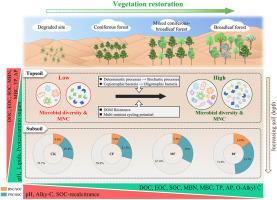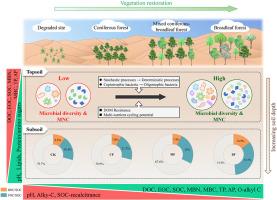Vegetation restoration shapes soil organic matter chemistry and microbial processes
IF 10.3
1区 农林科学
Q1 SOIL SCIENCE
引用次数: 0
Abstract
Vegetation restoration is a critical process for the recovery of ecosystem functioning in red soil (Ultisol) erosion areas, yet the mechanisms underlying its effects on soil organic carbon (SOC) stability and nutrient cycling remain poorly understood. By integrating 13C-NMR spectroscopy, Fourier transform ion cyclotron resonance mass spectrometry (FT-ICR MS), and microbial necromass quantification, this study elucidates the dynamic coupling mechanisms among SOC composition, dissolved organic matter (DOM) molecular signatures, and microbial necromass carbon (MNC) across vegetation types and soil depths in red soil erosion areas of southern China. Vegetation restoration significantly decreased mean soil pH from 5.02 to 4.54 in topsoil (0–10 cm) (P < 0.05). The dissolved organic carbon concentration in topsoil increased from 75.1 mg kg−1 in the degraded site (CK) to 217 mg kg−1 in broadleaf forest over 80 years old (BF) (P < 0.05) and that of easily oxidizable carbon concentrations increased from 0.48 to 2.77 g kg−1 (P < 0.05). 13C-NMR analysis revealed a decline in the relative abundance of alkyl C in SOC with vegetation restoration, accompanied by an increase in O-alkyl C. DOM molecular characterization indicated that vegetation restoration promoted the accumulation of oxidized compounds (lignin- and tannin-like molecules) and reduced the abundance of reduced-state compounds (lipid- and protein/amino sugar-derived molecules). Thermodynamic analysis revealed that vegetation restoration decreased energy availability of DOM molecules. Vegetation restoration significantly enhanced MNC accumulation over 10-fold in both 0–10 cm and 20–40 cm soil layers compared to severely degraded zones (P < 0.05). Vegetation restoration significantly increased bacterial Shannon diversity and drove a bacterial community-level transition toward K-strategists, evidenced by a significant shift in the K:r ratio from 0.29 to 9.20 in 0–10 cm soil layer (P < 0.05). Moreover, the abundance of saprotroph-symbiotroph functional guilds in fungal communities increased with vegetation restoration. Path analysis confirmed that soil DOM parameters regulate microbial necromass accumulation and multi-nutrient cycling potential by mediating DOM ΔG0Cox and functional diversity. This study elucidates how vegetation restoration enhances SOC stability and ecological function recovery in red soils by reshaping DOM molecular signatures and microbial life-history strategies. These findings provide a framework for understanding and promoting carbon sequestration mechanisms in erosion-prone ecosystems, emphasizing the critical role of fungal necromass and DOM thermodynamics in long-term soil C stabilization.


植被恢复影响土壤有机质化学和微生物过程
植被恢复是红壤(Ultisol)侵蚀区生态系统功能恢复的关键过程,但其影响土壤有机碳(SOC)稳定性和养分循环的机制尚不清楚。通过13C-NMR谱、傅里叶变换离子回旋共振质谱(FT-ICR MS)和微生物坏死块定量分析,研究了中国南方红壤侵蚀区不同植被类型和土壤深度土壤有机碳组成、溶解有机质(DOM)分子特征和微生物坏死块碳(MNC)之间的动态耦合机制。植被恢复显著降低表层土壤(0 ~ 10 cm) pH, pH值由5.02降至4.54 (P < 0.05)。80年以上阔叶林表层土壤溶解性有机碳浓度从退化地(CK)的75.1 mg·kg-1增加到217 mg·kg-1 (P < 0.05),易氧化性碳浓度从0.48 g·kg-1增加到2.77 g·kg-1 (P < 0.05)。13C-NMR分析显示,植被恢复后有机碳中烷基C的相对丰度下降,o -烷基C增加。DOM分子表征表明,植被恢复促进了氧化化合物(木质素和单宁类分子)的积累,降低了还原态化合物(脂质和蛋白质/氨基糖源分子)的丰度。热力学分析表明,植被恢复降低了DOM分子的能量有效性。植被恢复后,0-10 cm和20-40 cm土层的MNC积累均比严重退化区增加了10倍以上(P < 0.05)。植被恢复显著增加了细菌Shannon多样性,并推动细菌群落水平向K-战略型转变,0-10 cm土层K:r比值从0.29显著转变为9.20 (P < 0.05)。此外,真菌群落腐生共生功能行会的丰度随植被恢复而增加。通径分析证实土壤pH通过介导DOM ΔG0Cox和功能多样性调控微生物坏死块积累和多养分循环潜力。本研究通过重塑DOM分子特征和微生物生活史策略,阐明了植被恢复对红壤有机碳稳定性和生态功能恢复的促进作用。这些发现为理解和促进易侵蚀生态系统的碳固存机制提供了一个框架,强调了真菌坏死团和DOM热力学在长期土壤C稳定中的关键作用。
本文章由计算机程序翻译,如有差异,请以英文原文为准。
求助全文
约1分钟内获得全文
求助全文
来源期刊

Soil Biology & Biochemistry
农林科学-土壤科学
CiteScore
16.90
自引率
9.30%
发文量
312
审稿时长
49 days
期刊介绍:
Soil Biology & Biochemistry publishes original research articles of international significance focusing on biological processes in soil and their applications to soil and environmental quality. Major topics include the ecology and biochemical processes of soil organisms, their effects on the environment, and interactions with plants. The journal also welcomes state-of-the-art reviews and discussions on contemporary research in soil biology and biochemistry.
 求助内容:
求助内容: 应助结果提醒方式:
应助结果提醒方式:


